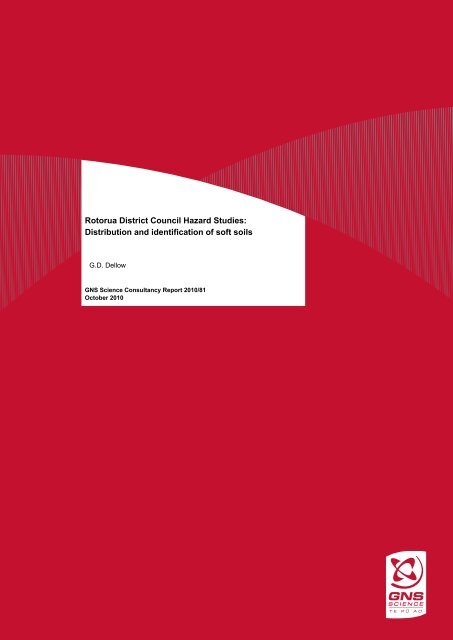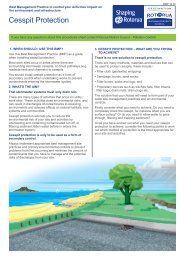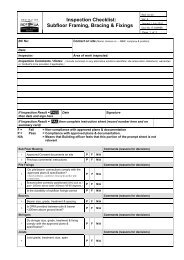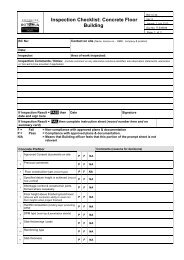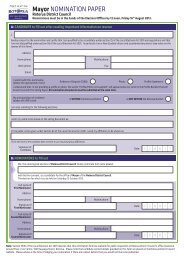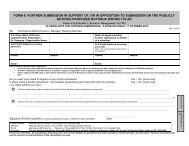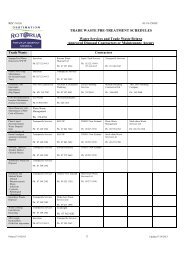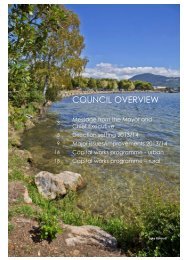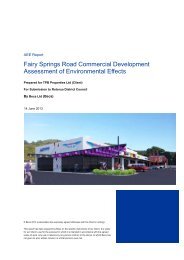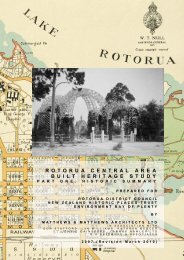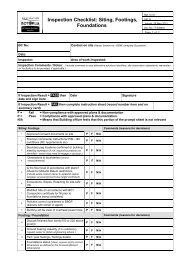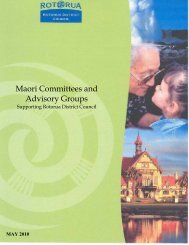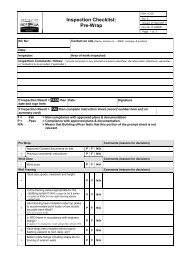Soft Soil Hazard Report - Rotorua District Council
Soft Soil Hazard Report - Rotorua District Council
Soft Soil Hazard Report - Rotorua District Council
Create successful ePaper yourself
Turn your PDF publications into a flip-book with our unique Google optimized e-Paper software.
DISCLAIMER<br />
This report has been prepared by the Institute of Geological and<br />
Nuclear Sciences Limited (GNS Science) exclusively for and under<br />
contract to <strong>Rotorua</strong> <strong>District</strong> <strong>Council</strong>. Unless otherwise agreed in<br />
writing by GNS Science, GNS Science accepts no responsibility for<br />
any use of, or reliance on any contents of this <strong>Report</strong> by any person<br />
other than <strong>Rotorua</strong> <strong>District</strong> <strong>Council</strong> and shall not be liable to any<br />
person other than <strong>Rotorua</strong> <strong>District</strong> <strong>Council</strong>, on any ground, for any<br />
loss, damage or expense arising from such use or reliance.<br />
BIBLIOGRAPHIC REFERENCE<br />
Dellow, G.D., 2010. Distribution and engineering properties<br />
of young lake sediments in <strong>Rotorua</strong> <strong>District</strong>, GNS Science<br />
Consultancy <strong>Report</strong> 2010/81. 13p.<br />
Project Number: 420W1342
Confidential 2010<br />
CONTENTS<br />
EXECUTIVE SUMMARY .........................................................................................................II<br />
1.0 INTRODUCTION ..........................................................................................................1<br />
2.0 GEOLOGICAL DATA ..................................................................................................1<br />
3.0 GEOTECHNICAL DATA..............................................................................................4<br />
4.0 DISCUSSION ...............................................................................................................4<br />
5.0 CONCLUSIONS ...........................................................................................................7<br />
6.0 RECOMMENDATIONS ................................................................................................8<br />
7.0 ACKNOWLEDGEMENTS ............................................................................................8<br />
8.0 REFERENCES .............................................................................................................8<br />
9.0 GLOSSARY ...............................................................................................................10<br />
9.1 Abbreviations............................................................................................................... 10<br />
9.2 Technical terms ........................................................................................................... 10<br />
FIGURES<br />
Figure 1 Distribution of soft to very soft ground within <strong>Rotorua</strong> <strong>District</strong>. ...........................................................5<br />
GNS Science Consultancy <strong>Report</strong> 2010/81<br />
i
Confidential 2010<br />
EXECUTIVE SUMMARY<br />
The <strong>Rotorua</strong> <strong>District</strong> <strong>Council</strong> (RDC) has commissioned GNS Science to undertake a study<br />
describing the distribution and engineering properties of soft to very soft sediments in the<br />
<strong>Rotorua</strong> <strong>District</strong>. The RDC has identified soft and very soft sediments as a potential<br />
geological hazard in the district because when additional loads are applied (e.g. by fill<br />
placement or building construction) they can produce differential settlements. This has<br />
damaged and has the potential to damage buildings and other infrastructure founded on<br />
these materials.<br />
<strong>Soft</strong> and very soft sediments are usually formed when fine grained materials (fine sands and<br />
silts) are deposited in a low energy environment (e.g. settle out of suspension in a standing<br />
water body such as a lake or swamp). As these sediments age, they settle and consolidate<br />
(become stronger).<br />
The locations of very soft to soft sediments in the <strong>Rotorua</strong> <strong>District</strong> is largely confined to<br />
swamp deposits, stream and river deltas marginal to lakes in the district and young lacustrine<br />
(lake) sediments deposited around Lake <strong>Rotorua</strong> between the 9000 year-old and current<br />
shorelines and which may now be overlain by younger alluvium and fan deposits.<br />
The identification of soft to very soft sediments can be made using standard investigation<br />
techniques commonly used in the geotechnical community. In this instance the scala<br />
penetrometer test has been selected as one test method because it is already in widespread<br />
use as a hand-tool to measure ground strength at the individual residential lot scale. In areas<br />
where soft to very soft sediments are likely to be located deeper than two metres a cone<br />
penetrometer test (CPT) should be carried out with a rig capable of reaching depths of<br />
twenty metres.<br />
The scala penetrometer test, if evaluated using the criteria set out in NZS 3604 (draft<br />
DZ3604), can identify areas of soft to very soft sediments (sites that fail to meet the criteria of<br />
good ground). However, because the scala penetrometer test is commonly not taken deeper<br />
than two metres, it is most useful where soft to very soft sediments are present in the surficial<br />
layer. Areas where rocks and soils derived from volcanic processes and sediments older<br />
than 10,000 years are mapped will likely have soft or very soft soil units present as thin,<br />
young surficial deposits on top of the older surfaces. The scala penetrometer test is suitable<br />
for identifying soft or very soft ground in these areas.<br />
In areas where the soft to very soft sediments might be buried by a younger deposit, either<br />
Holocene alluvium or recent fill (made ground) then the scala penetrometer test may lack<br />
sufficient penetration to reach the soft to very soft materials. In this instance a CPT test to a<br />
depth of at least 10 m and preferably 20 m is required to establish the presence (or absence)<br />
of soft or very soft sediments (q c < 0.3 MPa). The areas where the cone penetrometer test is<br />
required to definitively confirm the presence or absence of soft to very soft soil units are<br />
swamp deposits and stream and river deltas of Holocene age (0 to 10,000 years old)<br />
marginal to lakes in the district and young lacustrine (lake) sediments deposited around Lake<br />
<strong>Rotorua</strong> between the 9000 year-old and current shorelines and which may now be overlain<br />
by younger alluvium and fan deposits.<br />
GNS Science Consultancy <strong>Report</strong> 2010/81<br />
ii
Confidential 2010<br />
1.0 INTRODUCTION<br />
The <strong>Rotorua</strong> <strong>District</strong> <strong>Council</strong> (RDC) has commissioned GNS Science to undertake a study<br />
describing the distribution and engineering properties of soft to very soft sediments in the<br />
<strong>Rotorua</strong> <strong>District</strong>. The RDC has identified soft and very soft sediments as a potential<br />
geological hazard in the district because when additional loads are applied (e.g. by fill<br />
placement or building construction) they can produce differential settlements. This has the<br />
potential to damage buildings and other infrastructure founded on these materials.<br />
The scope of work involved in the report is to:<br />
• Review existing published and unpublished geological maps to ascertain the distribution<br />
of soft to very soft sediments within the boundaries of the <strong>Rotorua</strong> <strong>District</strong>. The age of<br />
the soft to very soft sediment deposits will be determined as geologic age is likely a key<br />
indicator of the level of hazard (i.e. the younger the sediments the more hazardous they<br />
potentially are). A map identifying the areas of soft to very soft sediments in the <strong>Rotorua</strong><br />
<strong>District</strong> will be provided.<br />
• Review geotechnical data for soils in the <strong>Rotorua</strong> <strong>District</strong>. The review of geotechnical<br />
information will allow the identification of appropriate investigation tools and methods for<br />
proving/disproving the presence of very soft to soft soils. As part of this the parameter<br />
values for diagnosing the presence of soft to very soft soils will be provided.<br />
• Prepare a report describing the work carried out above. The information provided in the<br />
report will enable the <strong>Rotorua</strong> <strong>District</strong> <strong>Council</strong> to formulate suitable policies and rules for<br />
identifying and mitigating this hazard in the context of the <strong>District</strong> Plan.<br />
2.0 GEOLOGICAL DATA<br />
The formation of very soft to soft sediments usually requires a specific set of environmental<br />
conditions. These environmental conditions can be characterised as the deposition of fine<br />
grained sediments in a low energy environment. An example is the deposition of fine sands<br />
and silts carried in water-born suspension in a lake delta. Only fine-grained sediments (fine<br />
sands, silts and clays) can be deposited using low-energy processes (insufficient energy is<br />
available to move larger particle sizes). The settling out of fine-grained materials carried in<br />
suspension results in the formation of sediments with open, loosely packed structures. It is<br />
this open, loosely packed structure that allows settlement to occur when additional loads are<br />
applied at the ground surface (e.g. by the placement of fill or construction of a building).<br />
These sediments settle and consolidate with time through compaction (including compaction<br />
induced by liquefaction during strong earthquake shaking), burial and weathering. Therefore<br />
to identify the areas in <strong>Rotorua</strong> <strong>District</strong> where very soft to soft sediments might be present it<br />
is necessary to locate the sites of young, fine-grained sediments deposited in a slack water<br />
environment.<br />
GNS Science Consultancy <strong>Report</strong> 2010/81 1
Confidential 2010<br />
A map of the geology of the <strong>Rotorua</strong> <strong>District</strong> was compiled using the best available data.<br />
The composite geological map used three data sources. These are:<br />
1. The 1:50,000 scale unpublished geological map of the Upper Kaituna Catchment<br />
prepared by William Esler. Although unpublished this map has been used as source data<br />
for the new 1:250,000 scale geological map of the <strong>Rotorua</strong> area. The Esler map is used<br />
because of the fine detail of the mapping around the margins of Lake <strong>Rotorua</strong>. Esler<br />
states in his notes accompanying the map that one of his intents was to map the<br />
distribution of soft to very soft soils that cause problems for civil engineering works.<br />
2. The 1:50,000 Okataina map by Ian Nairn. The scale of the map allows for a better<br />
resolution of geological information around most of the lakes in the <strong>Rotorua</strong> <strong>District</strong>; and<br />
3. The new 1:250,000 geological map of the <strong>Rotorua</strong> area (Leonard et al, in prep). This map<br />
was used to provide geological information in the areas of the district not covered by the<br />
two maps listed above.<br />
The geology of <strong>Rotorua</strong> <strong>District</strong> is dominated by the calderas of the Taupo Volcanic Zone<br />
(TVZ) and their products (ignimbrites). In the <strong>Rotorua</strong> <strong>District</strong> four calderas or rhyolitic<br />
volcanic centres are identified, namely the Okataina, <strong>Rotorua</strong>, Kapenga and Reporoa<br />
calderas (Nairn, 2002). Holocene eruptive activity has been recorded in the Okataina<br />
Volcanic centre but not in the others in the <strong>Rotorua</strong> <strong>District</strong>. Surrounding the calderas to the<br />
north, west and east are extensive ignimbrite sheets formed by older eruptions from the<br />
calderas (e.g. Mamaku Ignimbrite, Kaingaroa Ignimbrite, Rotoiti Breccia).<br />
The ignimbrite sheets of the <strong>Rotorua</strong> <strong>District</strong> (e.g. Mamaku Ignimbrite, Kaingaroa Ignimbrite,<br />
Rotoiti Breccia) do not provide conditions suitable for the formation of very weak (soft)<br />
sediments because no large standing water bodies are present or have been present in the<br />
past in these areas at the current ground surface (upper surface of thick ignimbrite sheets).<br />
The upper surfaces of the ignimbrites are usually covered in younger ash and the unwelded<br />
portion of the ignimbrite sheets. These materials are usually highly porous and easily eroded<br />
by water which precludes the formation of long-lived bodies of standing water such as lakes<br />
(and swamps).<br />
This leaves the calderas (large basins of volcanic origin) and their infill lakes within the<br />
Taupo Volcanic Zone as potential sites of very soft to soft sediments. Volcanic rocks and<br />
associated deposits (e.g. lavas, pyroclastic falls and flows, domes) can be eliminated<br />
because these units were deposited by high-energy processes and are therefore usually<br />
dense soils and/or rock. This leaves areas mapped as sedimentary rocks. The sedimentary<br />
rocks in the <strong>Rotorua</strong> <strong>District</strong> belong to one of five distinct units:<br />
1. Huka Group sediments ranging in age between >220 ka and 22 ka. These are usually<br />
mapped in three distinct groups (Nairn, 2002):<br />
a. The oldest Huka Group sediments (u 1 ) pre-date the Mamaku Ignimbrite. These are of<br />
sufficient age that any fine-grained materials deposited in a low-energy environment<br />
will be well consolidated by now. These sediments are primarily located within the<br />
Kapenga Caldera to the southwest of <strong>Rotorua</strong>, although isolated outcrops are found<br />
further to the east.<br />
GNS Science Consultancy <strong>Report</strong> 2010/81 2
Confidential 2010<br />
b. Sediments deposited after emplacement of the 220 ka Mamaku Ignimbrite but before<br />
emplacement of the 65 ka Earthquake Flat Pyroclastics (u 2 ). These sediments are<br />
predominantly located within the Kapenga Caldera southwest of <strong>Rotorua</strong>.<br />
c. Huka Group sediments aged between 65 ka and 22 ka deposited in the <strong>Rotorua</strong><br />
caldera during the lake high-stand (u 3 ) and now exposed (or buried by younger<br />
deposits) between the former high-water mark and the current lake margin. Minor<br />
deposits have also been identified along the course of the Tarawera River.<br />
2. The Hinuera Formation (20 ka). The Hinuera Formation (hn) consists of Rhyolitic sands<br />
and gravels forming fluviatile terrace and fan deposits (Nairn, 2002). Most of these<br />
sediments were deposited at the peak of the last glaciation about 20 ka. They are<br />
predominantly mapped in the Reporoa caldera to the south-west of <strong>Rotorua</strong> although<br />
small areas are also mapped within the Kapenga caldera.<br />
3. Holocene sediments (
Confidential 2010<br />
3.0 GEOTECHNICAL DATA<br />
The <strong>Rotorua</strong> <strong>District</strong> <strong>Council</strong> has provided several reports containing geotechnical<br />
information relating to very soft to soft sediments present in the district (e.g. Cowbourne,<br />
2010; Phillips, 2009). In these reports geotechnical data is provided for soft to very soft<br />
sediments from the results of scala penetrometer tests (most reports) and cone penetrometer<br />
tests (CPT).<br />
In the draft New Zealand Standard for timber framed buildings (DZ3604) ‘good ground’ (i.e.<br />
ground that requires no engineering modification or special design provisions for building<br />
construction) can be identified using the scala penetrometer. If the criteria for establishing<br />
the presence of good ground were used against the provided scala penetrometer test results<br />
then sites at Ohinemutu (Cowborne, 2010), Lynmore (Robinson, 2004) and Te Akau Rd,<br />
Lake Rotoiti (Fitchett, 2007) fail to meet the criteria. The site at Ngongotaha presents a<br />
mixed bag with respect to the scala penetrometer results. Some tests results indicate good<br />
ground is present as per the criteria proposed for the draft NZS 3604, while other test results<br />
show that good ground is not present using the criteria.<br />
Additional testing using CPT’s was undertaken at Ngongotaha (Phillips, 2009) and at Koutu<br />
(Cowbourne, 2009). These tests (and subsequent geotechnical tests) established that for 8-<br />
12 metres below the ground surface significant intervals (up to 10 metres) of soft to very soft<br />
sediments were present. Based on the results of the CPT tests, the soft to very soft<br />
sediments were defined as intervals were the cone resistance (q c ) was less than 0.3 MPa.<br />
In summary, where soft to very soft sediments are the surficial deposit then the criteria for<br />
interpreting the results of a scala penetrometer test as set out in the draft NZS 3604 is<br />
adequate for identifying the presence (or absence) of soft or very soft sediments within two<br />
metres of the ground surface. Where the soft to very soft sediments may be buried or<br />
overlain by younger sediments, then a CPT to a depth of at least 10 m and preferably 20 m is<br />
required to establish if substantial (i.e. greater than 1 m thick) thicknesses of soft to very soft<br />
sediments are present.<br />
4.0 DISCUSSION<br />
A map of the location of soft ground in the <strong>Rotorua</strong> <strong>District</strong> is provided as Figure 1. The map<br />
displays areas where soft ground is present as well as areas where soft ground may have<br />
been present in the past. Four zones are mapped:<br />
GNS Science Consultancy <strong>Report</strong> 2010/81 4
Confidential 2010<br />
Figure 1<br />
Distribution of soft to very soft ground within <strong>Rotorua</strong> <strong>District</strong>.<br />
GNS Science Consultancy <strong>Report</strong> 2010/81 5
Confidential 2010<br />
Zone A:<br />
Zone B:<br />
Zone C:<br />
Zone D:<br />
Areas of volcanic-derived rocks and soils. Volcanic processes by their very<br />
nature are high-energy. No soft ground is expected in zone A as the dominant<br />
processes preclude the conditions necessary for its development.<br />
Huka Group sediments and Hinuera Formation. These sediments were formed in<br />
a range of environments. Sediments with soft and very soft strengths at the time<br />
of formation have consolidated over time and are now likely to meet the<br />
requirements for being defined as good ground as per the draft New Zealand<br />
Standard for timber framed buildings (DZ3604).<br />
Undifferentiated Holocene alluvium. Sites from a range of environmental<br />
conditions are present within this zone. Small areas of soft to very soft ground<br />
may be present as a surficial layer in some places.<br />
Sites of Holocene (last 10,000 years) swamp deposits and Holocene lake or delta<br />
sediments between the 9000 ka and modern shorelines. Four of the five<br />
documented sites of soft ground (Fitchett, 2007; Phillips, 2009; and Cowbourne<br />
2009, 2010) are located at sites mapped as Zone D.<br />
Zones A, B and C only have a little soft or very soft ground or none at all. A scala<br />
penetrometer used to depths of at least 2 m in these areas should confirm the presence or<br />
otherwise of ‘good ground’ as per the draft New Zealand Standard for timber framed<br />
buildings (DZ3604). Any soft ground will be small in extent and at the surface if present.<br />
RDC provided a number of geotechnical reports for various localities in the district. Only one<br />
of these reports identified soft ground outside of Zone D. This was a site at Lynmore<br />
(Robinson, 2004) where the soft ground was picked up using a scala penetrometer. The site<br />
is also only between 100 and 500 metres from an area mapped as Zone D.<br />
Zone D contains extensive areas of soft ground, but probably also contains areas of better<br />
ground. The soft ground site described in Phillips (2009) at Ngongotaha is located on a valley<br />
floor containing a meandering stream. The Ohinemutu site described in Cowbourne (2010) is<br />
located on the lake delta of the Ohinemutu Stream, another small meandering stream.<br />
Several other small meandering streams are present on the western and south-western<br />
shores of Lake <strong>Rotorua</strong>. On the eastern and south-eastern shores of Lake <strong>Rotorua</strong> the small<br />
streams have straighter alignments, which if natural, indicate steeper stream gradients and<br />
hence a slightly higher energy environment and thus sediment with higher strengths.<br />
Additional sites of soft to very soft ground were identified at Koutu (Cowbourne, 2009) using<br />
CPT and Te Akau Rd on the shores of Lake Rotoiti (Fitchett, 2007) using a scala<br />
penetrometer. The CPT results at Koutu cannot be compared with scala penetrometer<br />
results but do indicate that the upper two metres of had q c values between 1-2 MPa.<br />
The site at Ngongotaha has had an influx of fine to coarse sand deposited by alluvial<br />
processes over the top of lake sediments. This probably explains the slightly better scala<br />
penetrometer results for the Ngongotaha site compared to the Ohinemutu site. However, the<br />
burial by slightly stronger sediments means that a scala penetrometer lacked the depth<br />
penetration to reach the soft sediments. In Zone D a scala penetrometer can only confirm the<br />
absence of ‘good ground’ as per the draft New Zealand Standard for timber framed buildings<br />
(DZ3604). A deeper test is therefore required to establish the presence of ‘good ground’. As<br />
demonstrated at Ngongotaha and Koutu a cone penetrometer probe to at least 20 m depth<br />
GNS Science Consultancy <strong>Report</strong> 2010/81 6
Confidential 2010<br />
(or refusal) is adequate for this task. <strong>Soft</strong> to very soft sediments can be defined as intervals<br />
where the measured cone resistance (q c ) is less than 0.3 MPa.<br />
Further refinement of Zone D to reduce the area of potentially soft ground is possible.<br />
Primarily this requires more extensive geotechnical information (scala, cone or standard<br />
penetrometer test results) that can be compared with the fine-scale geomorphology around<br />
the terrestrial margins of Lake <strong>Rotorua</strong>. These results could be used to further refine the<br />
mapping of soft and very soft soils in the <strong>Rotorua</strong> <strong>District</strong>.<br />
5.0 CONCLUSIONS<br />
<strong>Soft</strong> and very soft sediments are usually formed when fine grained materials (fine sands and<br />
silts) are deposited in a low energy environment (e.g. settle out of suspension in a standing<br />
water body such as a lake or swamp). Younger sediments are weaker than older sediments<br />
because as sediments age, they settle and consolidate (become stronger).<br />
Young, soft to very soft sediments are present at various localities within the <strong>Rotorua</strong> <strong>District</strong>.<br />
Three distinct environmental settings within the district are conducive to the formation of<br />
layers or beds of soft to very soft sediments. These areas are:<br />
1. Current or historical swamps;<br />
2. Stream and river deltas marginal to existing lakes; and<br />
3. Young lake sediments deposited around Lake <strong>Rotorua</strong> between the 9000 year-old and<br />
current shorelines and which may now be overlain by younger alluvium, fan deposits or<br />
even fill.<br />
The identification of soft to very soft sediments can be made using standard investigation<br />
techniques commonly used in the geotechnical community.<br />
The scala penetrometer test, if evaluated using the criteria set out in NZS 3604 (draft<br />
DZ3604), can identify areas of soft to very soft sediments (sites that fail to meet the criteria of<br />
good ground). However, because the scala penetrometer test is commonly not taken deeper<br />
than two metres it is most useful where soft to very soft sediments are present in the surficial<br />
layer. Areas where rocks and soils derived from volcanic processes and sediments older<br />
than 10,000 years are mapped will likely have soft or very soft soil units present as thin,<br />
young surficial deposits on top of the older surfaces. The scala penetrometer test is<br />
suitable/adequate for identifying soft or very soft ground in these areas (Zones A, B and C on<br />
Figure 1).<br />
In areas where the soft to very soft sediments might be buried by a younger deposit, either<br />
Holocene alluvium or recent fill (made ground) then the scala penetrometer test make lack<br />
sufficient penetration to reach the soft to very soft materials. In this instance a CPT test to a<br />
depth of at least 10 m and preferably 20 m is required to establish the presence (or absence)<br />
of soft or very soft sediments (q c < 0.3 MPa). The area where the cone penetrometer test is<br />
required to definitively confirm the absence of soft to very soft soil units is shown as Zone D<br />
on Figure 1.<br />
GNS Science Consultancy <strong>Report</strong> 2010/81 7
Confidential 2010<br />
6.0 RECOMMENDATIONS<br />
The following recommendations are made with respect to soft to very soft sediments in<br />
<strong>Rotorua</strong> <strong>District</strong>:<br />
It is recommended that the RDC develop a policy in relation to the district plan requiring<br />
mitigation of the hazard from soft or very soft ground. Examples of mitigation options<br />
available to parties required to operate under this policy include, for example, ground<br />
remediation, special foundation design provisions or avoidance.<br />
It is recommended that use of the scala penetrometer test (as per NZ3604; Draft DZ3604) be<br />
required to identify soft or very soft ground in Zones A, B and C (Figure 1). If the test results<br />
do not show good ground as per the method in NZS 3604, then soft or very soft soils are<br />
present. If soft or very soft ground is determined by this method then the hazard from soft to<br />
very soft ground needs to be mitigated as per RDC policy.<br />
In Zone D (Figure 1) it is recommended that the cone penetrometer test be used to identify<br />
soft or very soft ground. If the cone resistance (q c ) is less than 0.3 MPa then soft or very soft<br />
ground is present. If soft or very soft ground is determined by this method then the hazard<br />
from soft to very soft ground needs to be mitigated as per RDC policy.<br />
7.0 ACKNOWLEDGEMENTS<br />
Graham Leonard and Will Estler and thanked for their input into mapping the distribution of<br />
Quaternary sediments in the <strong>Rotorua</strong> area. Biljana Lukovic prepared the maps. Rob<br />
Langridge and Dick Beetham are thanked for their timely reviews.<br />
8.0 REFERENCES<br />
Cowbourne, A.J., 2009: Residential Subdivision, Ian Street, Koutu, <strong>Rotorua</strong> – Geotechnical<br />
Assessment <strong>Report</strong>. Unpublished report by Terrane Consultants Limited, Tauranga;<br />
dated 12/1/2009; 16 pages.<br />
Cowbourne, T., 2010: Proposed building extension, Tipu Ora Medical Centre, Ohinemutu;<br />
Preliminary <strong>Report</strong>. Unpublished report by Terrane Consultants Limited, Tauranga; dated<br />
25/3/2010; 6 pages.<br />
Esler, W., 2005. Upper Kaituna Geology. Unpublished geology map 1:50 000, <strong>Rotorua</strong>;<br />
dated 2/8/2005.<br />
Fitchett, P.F.R., 2007: Edgewater Trust – Application for subdivision consent of 130 Te Akau<br />
Road, Lake Rotoiti. Unpublished report by Sigma Consultants Limited, <strong>Rotorua</strong>; dated<br />
31/1/2007; 4 pages.<br />
Leonard, G.S., Begg, J.G., Wilson, C.J.N., (compilers) (in prep): Geology of the <strong>Rotorua</strong><br />
area. Institute of Geological & Nuclear Sciences 1:250 000 geological map 5. 1 Sheet.<br />
Lower Hutt, New Zealand: Institute of Geological & Nuclear Sciences Limited.<br />
Nairn, I.A., 2002: Geology of the Okataina Volcanic Centre, scale 1:50,000. Institute of<br />
Geological and Nuclear Sciences geological map 25. 1 sheet = 156 p. Lower Hutt, New<br />
Zealand: Institute of Geological and Nuclear Sciences.<br />
GNS Science Consultancy <strong>Report</strong> 2010/81 8
Confidential 2010<br />
NZS 3604, 2010: Timber framed buildings (draft [DZ3604] for public comment). New Zealand<br />
Standards, Wellington, New Zealand.<br />
Phillips, R., 2009: Western Road, Ngongotaha: Geotechnical assessment report prepared for<br />
Pioneer Property Trust. Unpublished report by Tonkin and Taylor Ltd; dated March 2009;<br />
377 pages (Volume 1 of 2).<br />
Robinson, A.J., 2004: G Spence – Proposed rezoning, Iles Rd, <strong>Rotorua</strong>. Unpublished report<br />
by Martin, McCauley Morton Limited, <strong>Rotorua</strong>; dated 24/6/2004; 34 pages.<br />
GNS Science Consultancy <strong>Report</strong> 2010/81 9
Confidential 2010<br />
9.0 GLOSSARY<br />
9.1 Abbreviations<br />
CPT<br />
ka<br />
m<br />
MPa<br />
q c<br />
TVZ<br />
Cone penetrometer test<br />
Thousand years<br />
metres<br />
Mega-pascals (units for measuring soil strength)<br />
Cone resistance (soil parameter measured during cone penetration testing)<br />
Taupo Volcanic Zone<br />
9.2 Technical terms<br />
Cone penetrometer test – a test for measuring ground strength using a truck or rig mounted<br />
probe. Used for depths below 2-3 metres. Can reach depths greater than 20 metres in<br />
suitable conditions.<br />
Fine-grained sediments – sands, silts and clays.<br />
Good ground – ground suitable for timber framed structures without ground modification of<br />
special foundation design provision. Defined using strength as measured by scala<br />
penetrometer test and the cone penetrometer test<br />
Lacustrine - of or relating to a body of fresh water.<br />
Low-energy processes – processes where the energy input into the system is very small.<br />
For example sediment, such as fine sands and silts, settling out of suspension is a lowenergy<br />
process compared to sediment being moved as bed-load transport, which requires<br />
high velocity flows and is a high-energy process.<br />
Scala penetrometer test – a test for measuring ground strength using a hand-held ground<br />
probe. Used for depths of 2-3 metres usually but can reach to five metres in some<br />
circumstances.<br />
<strong>Soft</strong> to very soft sediments - -ground not suitable for timber framed structures without ground<br />
modification of special foundation design provision. Defined using strength measured by the<br />
scala penetrometer test and the cone penetrometer test.<br />
GNS Science Consultancy <strong>Report</strong> 2010/81 10
Principal Location<br />
Other Locations<br />
1 Fairway Drive<br />
Dunedin Research Centre<br />
Wairakei Research Centre<br />
National Isotope Centre<br />
Avalon<br />
764 Cumberland Street<br />
114 Karetoto Road<br />
30 Gracefield Road<br />
PO Box 30368<br />
Private Bag 1930<br />
Wairakei<br />
PO Box 31312<br />
Lower Hutt<br />
Dunedin<br />
Private Bag 2000, Taupo<br />
Lower Hutt<br />
New Zealand<br />
New Zealand<br />
New Zealand<br />
New Zealand<br />
www.gns.cri.nz<br />
T +64-4-570 1444<br />
F +64-4-570 4600<br />
T +64-3-477 4050<br />
F +64-3-477 5232<br />
T +64-7-374 8211<br />
F +64-7-374 8199<br />
T +64-4-570 1444<br />
F +64-4-570 4657


